May 25, 2025 | 02:49 GMT +7
May 25, 2025 | 02:49 GMT +7
Hotline: 0913.378.918
May 25, 2025 | 02:49 GMT +7
Hotline: 0913.378.918
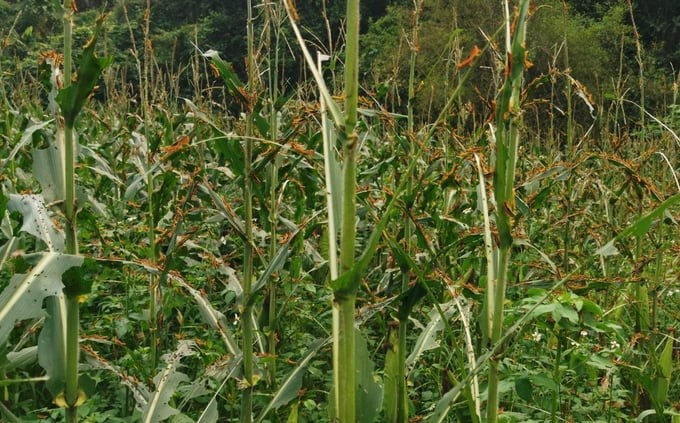
Yellow-spined bamboo locusts cause damage to corn plants in Kim Hy commune (Na Ri, Bac Kan). Photo: Nong Quang Hai.
In recent years, the yellow-spined bamboo locust has arisen and caused serious damage to both agricultural and forestry crops in China, Laos, and Vietnam. This is a creature that can move quickly, has great destructive power, and is difficult to control. When they are older, they can gather in large numbers and migrate to find food sources and places to lay eggs. Yellow-spined bamboo locusts were first recorded to cause damage to bamboo forests in 2008 in the provinces of Thanh Hoa, Son La, Dien Bien, and Phu Tho. By 2016, yellow-spined bamboo locusts had broken out, causing an epidemic and damaging over 3,700 ha of the agricultural and forestry crop area.
According to the law of annual harmful occurrences, on April 16, 2024, the Plant Protection Department coordinated with VTC16 to issue a bulletin on forecast, warning, and instruction on measures to prevent and control yellow-spined bamboo locusts in the Northern mountainous provinces. (https://www.youtube.com/watch?v=yD9n92_jDBM).
By May 30, 2024, the total area of yellow-spined bamboo locust outbreaks was 642 ha in the provinces of Cao Bang (517 ha in Hoa An, Nguyen Binh, Thach An, and Ha Quang), Dien Bien (0.5 ha), Son La (10 ha), Bac Kan (63 ha), Thanh Hoa (20 ha), and Nghe An (20 ha).
In Cao Bang, young locusts aged 2-4 years old are dispersing over a wider area. According to statistics from the Cao Bang Sub-Department of Livestock and Crop Production, the current area of locust outbreaks is over 517 ha, including 315.2 ha on bamboo forests, 165.2 ha on weeds, 26.8 ha on corn, 6.4 ha on rice, and 3.5 ha on tobacco. Areas with locusts are distributed in Hoa An district (Bach Dang, Hong Viet, and Le Chung communes, Nuoc Hai town); Nguyen Binh district (Vu Minh, Trieu Nguyen, The Duc, Thinh Vuong communes); Thach An district (Minh Khai, Canh Tan, Quang Trong, Kim Dong communes); Ha Quang district (Thanh Long, Luong Can communes, Thong Nong town); Cao Bang city (De Tham ward, Hung Dao commune, Chu Trinh commune); and some outbreaks in Bao Lam district (Thai Son commune).
On crops, the common density of locust is 80–150 heads/m2, and the high density is 200–400 heads/m2. On bamboo forests, the common density is 500–1,000 heads/m2; the high density is 2,500–3,000 heads/m2; and the local density is 7,000–8,000 heads/m2. On weeds, the common density is 200–400 heads/m2, and the high rate is 600–800/m2.
Yellow-spined bamboo locusts appear not only in Cao Bang but also in Van Vu commune, Na Ri district, Bac Kan province, with 63 ha of infected bamboo forests. Dien Bien province also has 0.5 ha of bamboo infected with locusts in Muong Nhe commune, Muong Nhe district; Son La has 10 ha in Tan Xuan commune, Van Ho district; and Lang Son has 11.6 ha in Thien Hoa commune, Binh Gia district, and Dai Dong and Khanh Long communes, Trang Dinh district.
Compared to the same period in previous years, the current bamboo locust-infected area is higher than in 2023 and 2022 but lower than in 2021 (over 1,000 ha, mainly distributed in the provinces of Son La, Cao Bang, Bac Kan, Dien Bien, Lai Chau, Phu Tho, Quang Ninh, Thanh Hoa, and Nghe An) and much lower than in 2016 (3,700 ha).
Localities have proactively investigated, detected, grasped the situation, and organized prevention and control according to the scale of each outbreak. The end of May is the time when locust nests hatch and begin to disperse. There are still many nests that have not been discovered, so localities need to direct the system of specialized plant protection agencies at the provincial and district levels to coordinate with commune and village governments, forest rangers, border guards, people, etc. to get information about young locust nests and prevent them as early as possible to achieve efficiency.
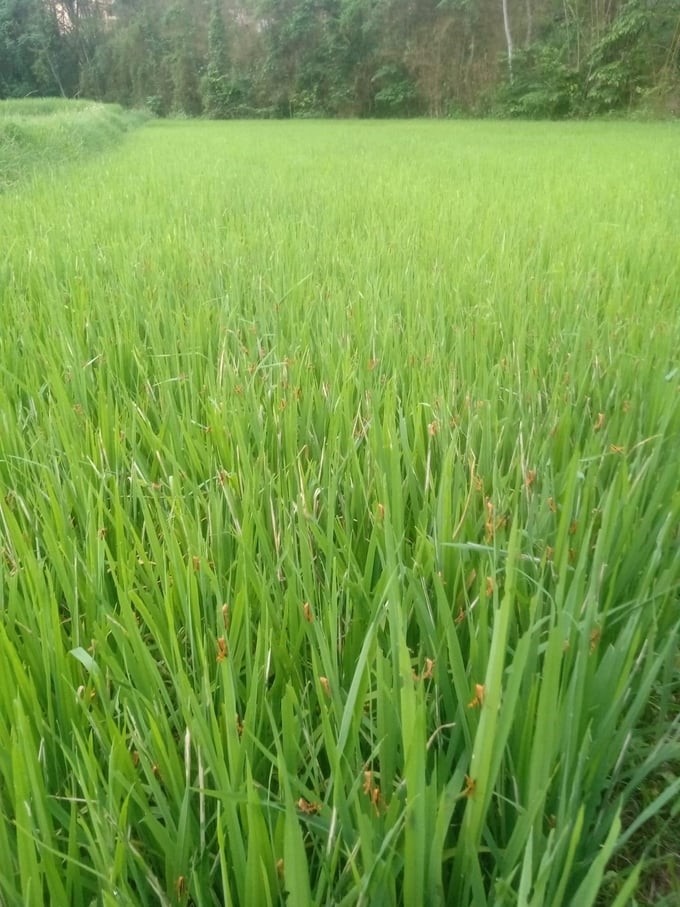
Yellow-spined bamboo locusts cause damage to rice in Binh Gia district, Lang Son.
+ Strengthen investigation, monitoring, detection, and treatment right from the moment of hatching to prevent the spread on a large scale, especially in places where there are many dead adult locusts from the previous year and concentrated egg laying areas, and monitor and determine the movement location of bamboo locusts.
+ Coordinate with the district People's Committee to direct all communes in the area to notify the harmful bamboo locust situation and direct preventive measures.
+ Promote dissemination and guide forest owners and farmers to increase inspection of areas of bamboo forests in the area; detect and early prevent and control; and immediately report to specialized agencies and local governments for timely measures.
+ Organize training on how to identify, prevent, and control yellow-spined bamboo locusts for farmer households.
+ Proactively mobilize all local resources to support farmers in spraying pesticides to kill locusts when they move down to harm agricultural crops.
+ It is necessary to strengthen investigating, monitoring, and forecasting the possibility of the appearance and development of yellow-spined bamboo locusts to proactively plan for prevention and control and promptly prevent widespread harm from occurring.
There are many natural enemies using young locusts as food, such as poultry, birds, omnivores, reptiles, etc., but when locusts break out in large numbers, it is essential to encourage people to apply measures to kill locusts in order: use rackets to catch locusts to make food (directly or processed) for poultry, compost into organic fertilizer, or destroy; use biological and chemical pesticides to spray to eliminate locusts (when spraying, spray in a surrounding or partial form to increase effectiveness). It is possible to use conventional pesticide spraying tools or use UAV equipment and fumigants, both of which are highly effective and suitable for the biological characteristics of locusts and the characteristics of mountains and forests.
In the current list of pesticides allowed for use in Vietnam, there are 3 types of pesticides registered to prevent and control yellow-spined bamboo locusts with active ingredients: Imidacloprid (Anvado 100WP), Thiosultap-sodium/nereistoxin (Neretox 95WP), Emamectin benzoate, and Lufenuron (Lufen extra 100EC).
Faced with the outbreak of yellow-spined bamboo locust, the Plant Protection Department has grasped the situation in the provinces and organized a delegation of officials to conduct field inspections in Cao Bang and a number of locations where outbreaks occurred. At the same time, coordinate and support localities to direct the prevention and control of yellow-spined bamboo locusts with the motto of prevention right from when the locusts have just hatched, the locusts are young, and the scope of the outbreak is still small to protect agricultural and forestry production.
Translated by Thu Huyen

(VAN) On May 23, Deputy Minister of Agriculture and Environment Tran Thanh Nam held a working session with a Japanese delegation on the application of digital technology in agricultural production.
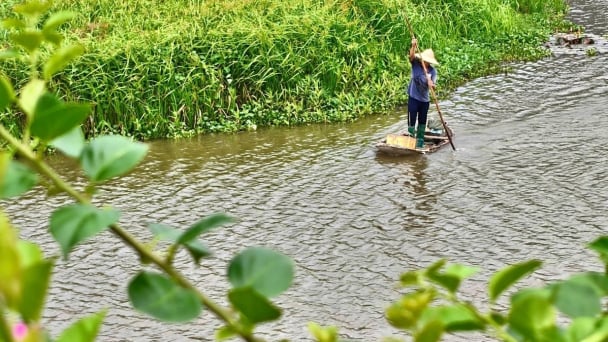
(VAN) In the tranquil wetlands of Van Long, there are quiet souls who guard the forests, nurture the waters, and oversee every bird and troop of langurs as protecting the essence of a living heritage.
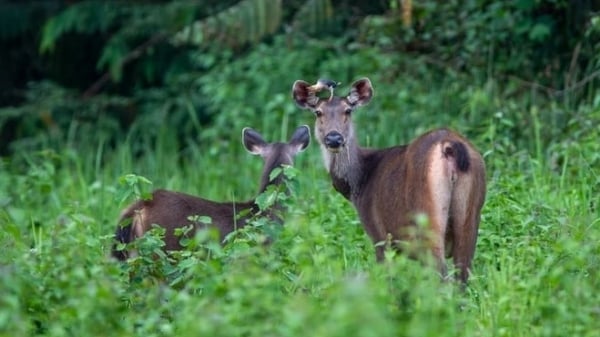
(VAN) WWF, GIZ, IUCN, UNDP call for biodiversity conservation and sustainable development must be regarded as a unity in strategies for a green future.
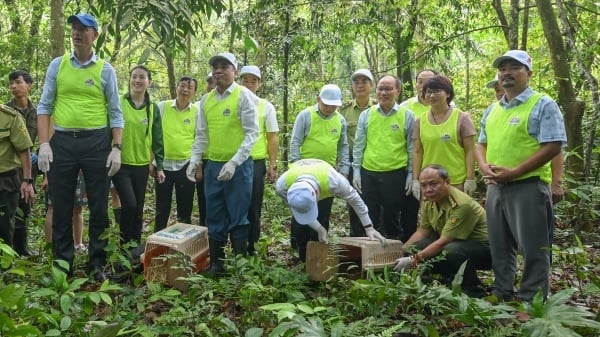
(VAN) On celebration of International Day for Biological Diversity, Deputy Minister Nguyen Quoc Tri called for practical actions to address nature and biodiversity conservation.
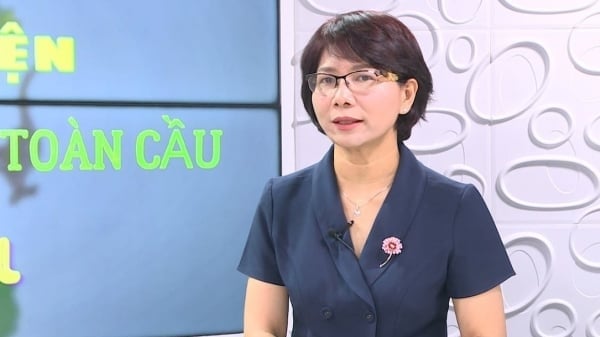
(VAN) Dr. Hoang Thi Thanh Nhan – Deputy Director of the Nature and Biodiversity Conservation Agency – highlighted this on the International Day for Biological Diversity, May 22, 2025.
![Ho Chi Minh city adapts to climate change: [2] Accelerating action](https://t.ex-cdn.com/nongnghiepmoitruong.vn/608w/files/chiqk/2025/05/22/4024-4220-bien-doi-khi-hau-1-100626_766.jpg)
(VAN) Clearly recognizing the challenges posed by climate change, Ho Chi Minh city has swiftly shaped its policies and implemented practical solutions to adapt.
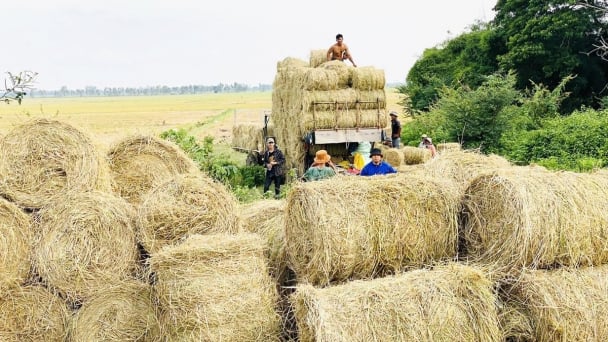
(VAN) Rice straw is no longer just a discarded byproduct, but it is becoming a green resource that helps farmers in the Mekong Delta reduce emissions and promote circular, sustainable agriculture.